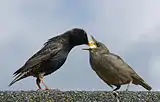Self-cannibalism
Self-cannibalism is the practice of eating oneself, also called autocannibalism,[1] or autosarcophagy.[2] A similar term which is applied differently is autophagy, which specifically denotes the normal process of self-degradation by cells. While almost an exclusive term for this process, autophagy nonetheless has occasionally made its way into more common usage.[3]
Among humans
As a natural occurrence
A certain amount of self-cannibalism occurs unknowingly, as the body consumes dead cells from the tongue and cheeks.
As a disorder or symptom thereof
Fingernail-biting that develops into fingernail-eating is a form of pica. Other forms of pica include dermatophagia,[4] and compulsion of eating one's own hair, which can form a hairball in the stomach. Left untreated, this can cause death due to excessive hair buildup.[5]
Self-cannibalism can be a form of self harm and a symptom of mental illnesses such as personality disorders, psychosis, or drug addiction.[6]
As a choice
Some people will engage in self-cannibalism as an extreme form of body modification, for example ingesting their own blood or skin.[3] Others will drink their own blood, a practice called autovampirism,[7] but sucking blood from wounds is generally not considered cannibalism.
Eating one's own placenta has a small following in Western cultures,[8] fostered by celebrities like January Jones.[9] Human placentophagy after childbirth is touted by some as a treatment for postpartum depression and fatigue, among other health benefits,[10] given its high protein, rich iron and nutrient content.[11] However, scientific research is inconclusive as to whether consuming the placenta has any health benefits.[12]
As a crime
Forced self-cannibalism as a form of torture or war crime has been reported. Erzsébet Báthory allegedly forced some of her servants to eat their own flesh in the early 17th century.[13] Incidents were reported in the years following the 1991 Haitian coup d'état.[14] In the 1990s, young people in Sudan were forced to eat their own ears.[15]
Among animals
The short-tailed cricket is known to eat its own wings.[16] There is evidence of certain animals digesting their own nervous tissue when they transition to a new phase of life. The sea squirt (with a tadpole-like shape) contains a ganglion "brain" in its head, which it digests after attaching itself to a rock and becoming stationary, forming an anemone-like organism. This has been used as evidence that the purpose of brain and nervous tissue is primarily to produce movement. Self-cannibalism behavior has been documented in North American rat snakes: one captive snake attempted to consume itself twice, dying in the second attempt. Another wild rat snake was found having swallowed about two-thirds of its body.[17]
References in myth and legend

The ancient symbol Ouroboros depicts a serpent biting its own tail.
Erysichthon from Greek mythology ate himself in insatiable hunger given him, as a punishment, by Demeter.
In an Arthurian tale, King Agrestes of Camelot goes mad after massacring the Christian disciples of Josephus within his city, and eats his own hands.
Manducation
In 1679, Phillip Rohr published a scientific study of the practice of "grave eating" which he called manducation ("Dissertatio de masticatione mortuorum"). The book brought together a wealth of accounts of the corpses found to have "consumed their own shrouds and winding cloths, and even their own limbs and bowels".[18] Rohr also describes particular sounds that are heard from the graves when a corpse either "laps like some thirsty animal" or chews, grunts and groans.[18] The 18th century also produced a considerable amount of literature on the subject.[19]
See also
- List of autocannibalism incidents
- Human placentophagy
- Eating mucus
Notes
- ""Man-eaters: The Evidence for Coastal Tupi Cannibalism" mei(sh) dot org". Archived from the original on 2006-06-25. Retrieved 2007-05-03.
- Mikellides AP (October 1950). "Two cases of self-cannibalism (autosarcophagy)". Cyprus Med J. 3 (12): 498–500. PMID 14849189.
- Benecke, Mark "First report of non-psychotic self-cannibalism (autophagy), tongue splicing and scar patterns (scarification) as an extreme form of cultural body modification in a Western civilization"
- Hayden, Danielle (5 November 2018). "What to Know About Dermatophagia, the 'Skin-Eating' Disorder That Causes Me to Gnaw at My Own Fingers".
- Sah DE, Koo J, Price VH (2008). "Trichotillomania" (PDF). Dermatol Ther. 21 (1): 13–21. doi:10.1111/j.1529-8019.2008.00165.x. PMID 18318881.
- Yilmaz, Atakan; Uyanik, Emrah; Şengül, Melike C. Balci; Yaylaci, Serpil; Karcioglu, Ozgur; Serinken, Mustafa (August 2014). "Self-Cannibalism: The Man Who Eats Himself". The Western Journal of Emergency Medicine. 15 (6): 701–2. doi:10.5811/westjem.2014.6.22705. PMC 4162732. PMID 25247046.
- NCBI PubMed
- Beacock, Michelle (2012-07-01). "Does eating placenta offer postpartum health benefits?". British Journal of Midwifery. 20 (7): 464–469. doi:10.12968/bjom.2012.20.7.464. ISSN 0969-4900. S2CID 73326778.
- "January Jones Eats Her Own Placenta". ABC News. Retrieved 2015-11-08.
- Sonne, S. R.; Bhalla, V. K.; Barman, S. A.; White, R. E.; Zhu, S.; Newman, T. M.; Prasad, P. D.; Smith, S. B.; Offermanns, S.; Ganapathy, V. (August 2013). "Biochimica et Biophysica Acta (BBA) - Molecular Basis of Disease". Biochimica et Biophysica Acta. 1832 (8): 1149–1158. doi:10.1016/j.bbadis.2013.04.006. PMID 23579073.
- Pratt, J.P.; Roderuck, Charlotte; Coryell, Margaret; Macy, Icie G. (1946-11-01). "Composition of the human placenta: III Vitamin content". American Journal of Obstetrics and Gynecology. 52 (5): 783–787. doi:10.1016/0002-9378(46)90185-8. ISSN 0002-9378. PMID 20273858.
- Lim, Robin (2015-04-08). Placenta : the forgotten chakra. Akiyama, Miyuki (Revised ed.). Bali, Indonesia. pp. 122, 128. ISBN 978-0976290773. OCLC 951498666.
- Adams, Cecil "Did Dracula really exist?" The Straight Dope
- Chin, Pat. "Behind the Rockwood case" Workers World, April 6, 1996
- Lambeth Daily News 6 August 1998
- Taber, Stephen Welton (2005) Invertebrates Of Central Texas Wetlands, page 200.
- Mattison, Chris (2007). The New Encyclopedia of Snakes. Princeton, N.J.: Princeton University Press. p. 105. ISBN 978-0-691-13295-2.
- Roger Luckhurst. The Cambridge Companion to "Dracula". Cambridge University Press, 2018. ISBN 9781107153172. P. 13.
- "BBC Radio 4 - in Our Time, Polidori's the Vampyre".
